PLD$ is involved in phagocytosis of microglia: expression and localization changes of PLD4 are correlated with activation state of microglia
- PMID: 22102906
- PMCID: PMC3216956
- DOI: 10.1371/journal.pone.0027544
PLD$ is involved in phagocytosis of microglia: expression and localization changes of PLD4 are correlated with activation state of microglia
Abstract
Phospholipase D4 (PLD4) is a recently identified protein that is mainly expressed in the ionized calcium binding adapter molecule 1 (Iba1)-positive microglia in the early postnatal mouse cerebellar white matter. Unlike PLD1 and PLD2, PLD4 exhibits no enzymatic activity for conversion of phosphatidylcholine into choline and phosphatidic acid, and its function is completely unknown. In the present study, we examined the distribution of PLD4 in mouse cerebellar white matter during development and under pathological conditions. Immunohistochemical analysis revealed that PLD4 expression was associated with microglial activation under such two different circumstances. A primary cultured microglia and microglial cell line (MG6) showed that PLD4 was mainly present in the nucleus, except the nucleolus, and expression of PLD4 was upregulated by lipopolysaccharide (LPS) stimulation. In the analysis of phagocytosis of LPS-stimulated microglia, PLD4 was co-localized with phagosomes that contained BioParticles. Inhibition of PLD4 expression using PLD4 specific small interfering RNA (siRNA) in MG6 cells significantly reduced the ratio of phagocytotic cell numbers. These results suggest that the increased PLD4 in the activation process is involved in phagocytosis of activated microglia in the developmental stages and pathological conditions of white matter.
Conflict of interest statement
Figures
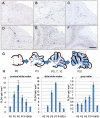

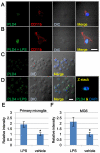
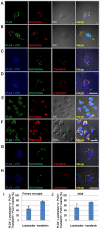
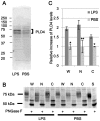
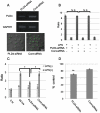

Similar articles
-
Phospholipase D family member 4, a transmembrane glycoprotein with no phospholipase D activity, expression in spleen and early postnatal microglia.PLoS One. 2010 Nov 11;5(11):e13932. doi: 10.1371/journal.pone.0013932. PLoS One. 2010. PMID: 21085684 Free PMC article.
-
Microglial phospholipase D4 deficiency influences myelination during brain development.Proc Jpn Acad Ser B Phys Biol Sci. 2016;92(7):237-54. doi: 10.2183/pjab.92.237. Proc Jpn Acad Ser B Phys Biol Sci. 2016. PMID: 27477458 Free PMC article.
-
Synaptotagmin-11 inhibits cytokine secretion and phagocytosis in microglia.Glia. 2017 Oct;65(10):1656-1667. doi: 10.1002/glia.23186. Epub 2017 Jul 7. Glia. 2017. PMID: 28686317
-
PLD4 promotes M1 macrophages to perform antitumor effects in colon cancer cells.Oncol Rep. 2017 Jan;37(1):408-416. doi: 10.3892/or.2016.5216. Epub 2016 Nov 3. Oncol Rep. 2017. PMID: 27840999
-
Migration and Phagocytic Ability of Activated Microglia During Post-natal Development is Mediated by Calcium-Dependent Purinergic Signalling.Mol Neurobiol. 2016 Mar;53(2):944-954. doi: 10.1007/s12035-014-9064-3. Epub 2015 Jan 10. Mol Neurobiol. 2016. PMID: 25575683
Cited by
-
The Role of Nucleases and Nucleic Acid Editing Enzymes in the Regulation of Self-Nucleic Acid Sensing.Front Immunol. 2021 Feb 26;12:629922. doi: 10.3389/fimmu.2021.629922. eCollection 2021. Front Immunol. 2021. PMID: 33717156 Free PMC article. Review.
-
Mammalian phospholipase D: Function, and therapeutics.Prog Lipid Res. 2020 Apr;78:101018. doi: 10.1016/j.plipres.2019.101018. Epub 2019 Dec 9. Prog Lipid Res. 2020. PMID: 31830503 Free PMC article. Review.
-
STING inhibition suppresses microglia-mediated synapses engulfment and alleviates motor functional deficits after stroke.J Neuroinflammation. 2024 Apr 8;21(1):86. doi: 10.1186/s12974-024-03086-8. J Neuroinflammation. 2024. PMID: 38584255 Free PMC article.
-
Proteomic analysis of hippocampus reveals metabolic reprogramming in a piglet model of mild hypoxic ischemic encephalopathy.PLoS One. 2025 Apr 24;20(4):e0320869. doi: 10.1371/journal.pone.0320869. eCollection 2025. PLoS One. 2025. PMID: 40273072 Free PMC article.
-
Deconvolution of Human Brain Cell Type Transcriptomes Unraveled Microglia-Specific Potential Biomarkers.Front Neurol. 2018 Apr 26;9:266. doi: 10.3389/fneur.2018.00266. eCollection 2018. Front Neurol. 2018. PMID: 29755398 Free PMC article.
References
-
- Pedersen KM, Finsen B, Celis JE, Jensen NA. Expression of a novel murine phospholipase D homolog coincides with late neuronal development in the forebrain. J Biol Chem. 1998;273:31494–31504. - PubMed
-
- Choi SY, Huang P, Jenkins GM, Chan DC, Schiller J, et al. A common lipid links Mfn-mediated mitochondrial fusion and SNARE-regulated exocytosis. Nat Cell Biol. 2006;8:1255–1262. - PubMed
-
- Munck A, Bohm C, Seibel NM, Hashemol HZ, Hampe W. Hu-K4 is a ubiquitously expressed type 2 transmembrane protein associated with the endoplasmic reticulum. FEBS J. 2005;272:1718–1726. - PubMed
Publication types
MeSH terms
Substances
LinkOut - more resources
Full Text Sources
Other Literature Sources
Molecular Biology Databases

